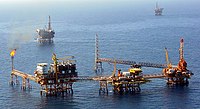
Photo from wikipedia
Offshore–onshore seismic survey is one of the main methods to study crustal structures in offshore–onshore transitional zones. At present, the seismic waves commonly used in imaging are the crustal refraction… Click to show full abstract
Offshore–onshore seismic survey is one of the main methods to study crustal structures in offshore–onshore transitional zones. At present, the seismic waves commonly used in imaging are the crustal refraction (Pg), the crustal reflection from the Moho (PmP), and the upper-mantle refraction (Pn) waves. The propagation distances of Pg and PmP are commonly less than 210 km, and Pn propagates with an apparent velocity of ∼8 km/s. In 2015, two offshore–onshore wide-angle seismic lines with a length of ∼350 km were acquired in the Pearl River Estuary. In addition to Pg, PmP, and Pn, a new seismic phase was observed, which has a long propagation distance (offset of ∼170–290 km), low apparent velocity (∼5.85 km/s), and low frequency (∼4–7 Hz). Similar seismic phases have been widely reported in previous offshore–onshore and reservoir seismic surveys, but the understanding of these phases is still limited. Herein, we used both raytracing and waveform modeling methods to identify the new seismic phase as the secondary Pg phase, which reflects from the surface (named Pg2Pg). We also discuss favorable conditions for Pg2Pg, including (1) a thin sedimentary layer with low velocity at the surface in which the reflection of Pg occurs, which can reduce the incidence angles and hence increase the energy of the reflected waves; (2) a sedimentary basement dipping toward the sea at the positions of the air gun shots, which focuses seismic waves; (3) relatively smooth interfaces of the medium, which can reduce the scattering of Pg2Pg; and (4) air guns that can excite low-frequency signals, which can reduce the attenuation of seismic waves. Checkerboard tests and practical applications show that Pg2Pg can significantly improve upper-crustal resolution, especially for onshore areas. Our research promotes the data mining of offshore–onshore seismic surveys, which is important for obtaining more detailed crustal structures.
Journal Title: Seismological Research Letters
Year Published: 2021
Link to full text (if available)
Share on Social Media: Sign Up to like & get
recommendations!